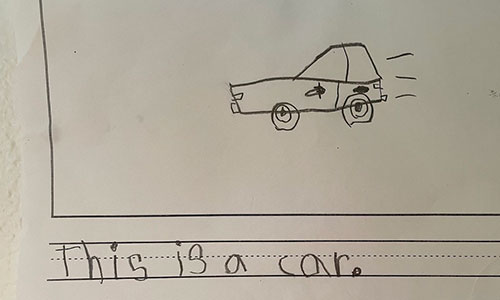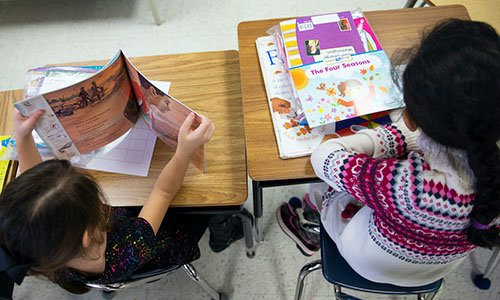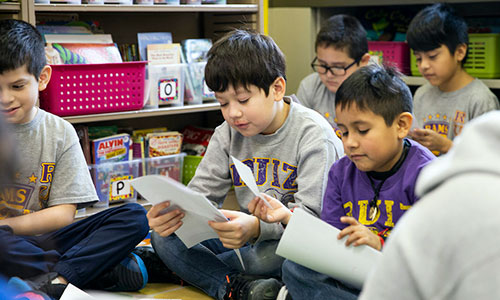
“We talk a lot about the power and joy of writing. But these students live it!”
This statement, followed by this video, sent shivers down my spine. That’s my colleague and national literacy expert, Miah Daughtery. She’s talking to me about her work with 826DC, a writing lab in our nation’s capital that serves primarily students of color.
826 DC is much like the organization’s other eight chapters. It offers a free, high-quality writing program to students ages 6–18 from under-resourced communities and provides an inspiring space for them to write. (Imagine a secret writer’s room hidden behind a magic shop.)
826 National is the national arm of the organization. It’s a non-profit focused on strengthening the writing of students, and it leads the largest youth writing network in the country. Its flagship writing center is in San Francisco at 826 Valencia Street (hence the name 826). 826 National supports nine local chapters across the country, each with community-based writing labs and in-school programs that serve around 25,000 students annually. It publishes about 750 unique pieces of student writing a year, like these, and it equips educators and families with free resources at 826 Digital to help every student discover the power and joy of writing.
I recently sat down with Laura Brief, the CEO of 826 National, for a virtual chat over Zoom. We were joined by Miah Daughtery, vice president of academic advocacy for NWEA, and a board member of 826DC since 2017. What unfolded was an enlightening conversation about how to empower young writers and move the national conversation about writing forward. Note that my questions and their answers have been lightly edited for length and clarity.
Tell me a bit about how 826 got started. I’m especially interested in how the organization provides a third space for writing, a place outside of home and school.
Laura: 826 National began with a vision of being a unique writing resource that offers students personalized writing support. Both teachers and students have been at the heart of what we do from the very beginning. The organization was founded in 2002 by the author Dave Eggers (A Heartbreaking Work of Staggering Genius, The Circle) and the educator Nínive Calegari, a former public school teacher with a master’s degree from the Harvard Graduate School of Education.
There’s long been an understanding that students need a space where they can engage with writing in a meaningful way, outside of school or home environments. The founders wanted the space to be something that students immediately sensed was different. The space at 826 Valencia looks like the hull of a pirate ship, and the writing center is hidden behind this whimsical, pirate-themed storefront. Young people know right away this space is for them. It’s honest and weird and wacky. (The shop sells pirate-y merchandise, alongside books written by 826 students, all in support of the organization.) But the store is also a way to invite the community in.
Miah: 826 DC follows the same model. Our theme is “Writing is magic,” and the storefront is a magic shop. Students enter the lab through a small Alice-in-Wonderland-sized door, and they know they’re entering a different world with different rules. Once inside, they see a massive library of books, including our student anthologies.
What have you noticed about student motivation in the writing lab environment? What gets students most excited about writing there?
Laura: When students get to see the books they’ve published on a bookshelf next to books written by authors they admire, it creates tremendous pride…and agency.
When I first started working for 826 as a volunteer, I went to Everett Middle School, which offers a specialized English immersion program for newcomer students. (826 National directly serves 20,000 educators, extending its impact to an additional 750,000 students.) What impressed me most was how the 826 facilitators connected writing to students’ lives. They asked students to write a poem using a guided prompt (“I saw…and now I see…”). The students were sitting in small groups at tables with adult volunteers and staff. When they started writing, there was a palpable shift in the room. What was real for them was being brought to life in the classroom. Not only were they learning to write a poem, but the text of their lives was the source material.
In our writing labs, we let who the students are, and what they bring with them, be a guide for their writing. We also invite students to get curious and embrace the boundless possibility of their creativity. They can feel this the moment they come through the door.
Miah: I see students at 826DC being genuinely jazzed about writing. What makes the 826 writing lab compelling for students is that they have so much choice over what they write. We’re not trying to replicate school. But we do partner with schools. Our staff knows writing pedagogy. They know the research about how students learn to write. And they have an awareness of state standards.
I’ve heard that students and their siblings return to the 826 writing labs year after year. What advice can you give classroom teachers about building writing communities?
Laura: This scenario happens across all our chapters. The students become our best champions. After they finish school, they come back to volunteer, teach, and even become board members.
One aspect of our program that could be replicated in classrooms is building a writing community. This can start by giving students opportunities to collaborate with fellow writers through group inquiry or creative problem-solving. Then it’s important to model and normalize how peers can learn from each other. For every writing lesson, we build in time for reflection and dialogue, and we make peer editing an integral part of the writing process. We emphasize curiosity-driven feedback, asking students what they find interesting or what they want to know more about when reading a peer’s work.
We also create opportunities for students to show up in the collective writing space as their authentic selves. We do this through the way we scaffold the writing prompts and the writing process but also by putting in the work to create a brave space. We work hard to give students a sense of ownership over the space and a sense of agency over their writing projects. We may start by naming a goal for the project, but the students define how we reach that goal.
Miah: One reason we have so many families come back is that we literally and figuratively invite the community in. We have open houses, and we do projects that are for the DC community, like when our students read their work at the Kennedy Center. We also work hard to cultivate a safe, warm, and inviting space where students—and their families—want to be. We invite students into the conversation by asking, “What’s important to you?” We also invite in a bit of chaos, but in a positive way. We ask students to take that creative energy and funnel it into their writing.
How does 826 encourage students to talk about their writing and get feedback? How have you seen such collaboration help improve students’ writing?
Laura: One technique we use is a “grumpy editor,” an imaginary editor who taunts students but also gives positive feedback. At 826 Valencia, our grumpy editor is Captain Blue. I was at the writing center a couple of weeks ago, and some third-grade students came up to me. One said, “We heard no one has ever seen Captain Blue. Will we get to meet him?” I told them to wait and see. Then they hear a booming voice from above. “Kids can’t write books!” Captain Blue says, very grumpily. Now the kids are all atwitter. Captain Blue goes on to give one sentence of personalized feedback for each kid’s writing—emphasizing how wonderful it is—which is so motivating.
826 students also collaboratively write books, which gets them talking about writing from day one. The writing process often begins with verbal sharing to clarify intentions and get feedback before putting a pen to the page. From there, students must rely on one another for feedback, for coaching, for editing, and for cheerleading. Each chapter also creates a student editorial group that provides feedback to writers within the book. This mirrors the professional writing process in the real world and empowers students to see themselves as both authors and editors. One of the best things teachers can do in their classrooms is identify as writers themselves—go through the process of writing and getting feedback themselves—because it models this collaboration.
We also work hard to create spaces where students feel physically and psychologically safe. It shows up in how we teach writing and in what we praise about students’ writing. 826 students really understand that failure is a part of writing. That’s the beauty of editing. Writing is a process. And by editing, you are making adjustments to it, just like in life.
Miah: When students write, they are taking a piece of themselves and making it visible to other people. It is an act of vulnerability that requires both bravery and trust. Writing among individuals you feel safe around, those who give you a sense of community, builds that trust. So, I would encourage educators to reach out to the 826 network and collaborate on building a writing community because this is where 826 really excels with young writers.
Your writers have real audiences, through their published anthologies and public readings, often to large audiences. What can schools learn from 826’s approach to amplifying writers’ voices?
Laura: We are big believers in publishing. We produce a series of reports each year on the effectiveness of our programs, and our research shows that publishing student writing has benefits that go well beyond the pages of the book. Writing is a powerful tool that lets students grapple with their own stories and identities. When the element of a real audience is added, students gain a greater sense of pride in their writing. But they also begin to think about the impact of their words on the reader…and on the world.
A survey of educators who subscribed to our 826 Digital platform in 2021 revealed that only 18% printed a book of student writing and only 19% hosted an opportunity for students to read their writing. In an 826 survey of educators nationwide, 67% of respondents said they use student publications as writing models with their students. This tells us educators understand the value of student publications; they just aren’t able to publish student writing for reasons we can all guess.
For classroom teachers, we encourage finding times to really celebrate student writing—outside of the classroom, in unexpected ways, and in front of unexpected audiences. We also recommend making student writing as visible as possible—on school walls, in libraries, on billboards. Then honor student writing through a low-tech publishing method. Try partnering with the community, or other students, to develop art that frames the book to be as beautiful as the writing within it.
Miah: Real audiences raise the stakes of writing in a meaningful way. When students at 826DC know their writing will be published, they approach their writing as though it will be published. In 2019, Ron Charles, the book critic for TheWashington Post, reviewed that year’s anthology, This Time They Hear You, a collection of science-inspired fairy tales. This year, 826DC held the book release party at the Martin Luther King Jr. Memorial Library in downtown DC. Students read a selection of their writing to the community—friends and family, yes, but also whoever happened to be in the library that day. During the reading, what struck me most was how collegial the students were to each other. I saw middle schoolers cheering each other on, applauding each other’s work, and offering genuine praise. There was no teasing. No funny business—at all. Their writing was real, and they approached their opportunity to perform it seriously. At the end of the reading, Ron Charles sat down with the student-authors and interviewed them, just as he would any other published author. While every school writing assignment can’t have a real-world audience like this, even once a year would make a big difference.
Your website has a powerful banner about how writing changes lives, communities, and the future. How have you seen writing bring about such profound changes?
Laura: One way writing changes us is that it allows us to be ourselves. Writing can be a personal, internal tool for transformation. It can help you be yourself and understand yourself better. Writing can also be loud and powerful and public. It can help you to take that self and broadcast it into the world—to change lives through public change and civic engagement.
Being able to tell your story and amplify your story is incredibly powerful. An 826 student once had the opportunity to introduce Barack Obama at the Obama Foundation Summit, and she said, “I didn’t know then that stories could change the world, let alone a story that I had written.”
Learn more
To learn more about the 826 National Youth Writing program, including how you can support their work, visit them online. To learn more about professional development on writing instruction, visit our website.







